The term “winter mushrooms” sounds like an oxymoron to most people and for the most part, they are correct. But if you’re “in the know” this is not always the case. One needs to manage expectations though, as this tends to be more of a looking exercise than finding exercise @ this time of year. Information gained: priceless. But with this said, finding any mushrooms this time of year is an epiphany! I always find enoki mushrooms out by the last week of January/1st week of February in Denver. https://cmsweb.org/category/foray/foray-report/
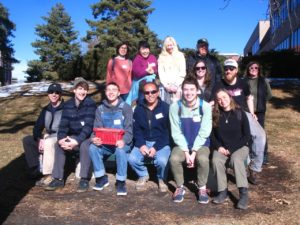
I was surprised this year to see oyster mushrooms out the 1st week of January ahead of the enokis though. Locating winter mushrooms is more of a journey than a destination in a sense. It is much like placer mining for gold but I’ll get back to this analogy in a moment. Basically, you need to do a lot of looking to find your reward. The positive thing about most saprophytic wood loving mushrooms is that once you find a patch, they generally come up several times a year, year after year. As far as enoki, I typically find 1-2 new locations every year. Existing locations don’t last forever though so I also lose one or 2 old locations almost every year as well. The mycelium will consume its food supply at some point and will stop producing-reproducing in actuality. If you want a steady supply of critters to find, you need to get out into the field at the right time of year! The key is knowing where to look & when. To get a better understanding, need to ask why they do what they do or more precisely; where they do fruit and why there. Orientation of microclimates is the primary key along with other mitigating factors. I will also go over conservation techniques to help the mushrooms that you do find from prematurely drying out at this time of the year.
The placer mining analogy, hunting gold to hunting mushrooms – placer gold is gold that is been washed away from its original formation location. To find mushrooms or gold you need to do 3 things. The 1st is prospecting, making sure what you’re looking for is where you’re looking. 2nd is reconnoitering, finding the exact location of the source of what you’re looking for. The 3rd is mining, getting your hands on what you’re looking for once you have found the source. With gold, you find some bits of gold in a stream, you follow the bread crumb trail upstream to the source, then you mine the source. With mushrooms, you find an appropriate ecosystem that can sustain the species of mushrooms you’re interested in, you find the host specific trees in a state in which the mushroom you’re interested in can utilize them and then you come back @ the appropriate time when the mushroom will fruit to collect your “gold”.
How to determine this information:
⦁ Orientation to the sun is the most important factor this time of year. North, South, East & West facing ecosystems are generally in different states of play at the same time of year. North and East facing orientation generally means that these ecosystems are frozen. The North because it’s facing away from the sun & the east because it is getting early morning “cold” sun and tend to have more shade in the warmer afternoons. Western orientations tend to be better possibilities because they are getting warmer afternoon sun but they tend to be more shaded in the morning. The ideal orientation this time of year is dead south. Mushrooms residing in a southern orientation almost have to fruit early in the season because within a short period of time, it will be too warm and dry for them to fruit.
Slope is the 2nd most critical factor and can be the primary factor in certain situations. In a nut shell, flat ground warms slower than ground tilted toward the sun. The greater the slope, the more sun exposure and faster warming. A southern facing slope at 45° with no shade is getting a full dose of sun. On the February 2 2019 CMS foray, the only live enoki & oyster mushrooms that were found were on southern facing 45° angle slopes along Cherry Creek. https://cmsweb.org/category/foray/foray-report/
Location selection is the 3rd most critical factor which will be the focus of the next section. You can really see the roles of orientation, shade and slope in action at this time of year, particularly when you have/had snow on the ground. The shaded northern facing side 45° bank of the creek was covered in snow & frozen. The open flat areas with a southern orientation were partially melted. The south facing 45° bank had no snow, a few spring greens and mushrooms. This is all within 50 yards of each other. A visual picture is worth a 1000 words.
Shade/location selection, is the next most important factor. Obviously if you have a building or fence blocking the sun, orientation becomes less important but the main shade to be concerned with is from trees. If you have a deciduous tree w/ no leaves, there is still about a 50% reduction in available sun light. A coniferous tree can block almost all the useful sun for a good part of the day if it is directly south or south west of the location of interest. So not only is the consideration of shade important but also the orientation of the shade as well. There are a few more factors that also affect finding mushrooms this time of year in Denver.
Altitude differences in Denver are measured in the hundreds of feet not thousands of feet like in the mountains. But hundreds of feet can make a big difference at this time of year. The confluence of Cherry Creek at the Platte River is definitely warmer than say the area below the Cherry Creek State Park dam. There might only be a 500 foot drop in elevation but this can add up to dramatic increase in temperature. The lower part of the creek can easily be a week ahead of the upper part of the creek.
The other factor that I find important in hunting urban mushrooms (which did not come into play in this particular foray) is the compass orientation of streets. Streets that run east to west tend to warm-up more quickly than streets that run North and South. This is because the trees on streets that run North and South are all in alignment and compound the shading of the ground. The trees on the streets that run east and west are spaced evenly apart and are relatively far away from the north side of the street which has the southern exposure. This tends to create a “hole” in the tree canopy which allows the sun to shine directly on the ground without interference. This also means inversely that streets on a north south orientation are better later in the season as they tend to be cooler and with moister soil than their East-West counterparts. There are many factors that determine when and where mushrooms will appear. By taking all of these factors into consideration, you are placing the odds in your favor. If you want to beat the house, you have to learn how to count these cards.
⦁ Location selection- The location of the Feb CMS Foray was carefully chosen for multiple reasons. The creek runs on a diagonal from Southeast to Northwest (it’s the reasons that all of the streets in downtown Denver are at a screwy 45° angle to north-south) This means that it has a south west facing orientation to the sun. There is a 45° angle bank running most of its length. It’s low altitude & has multiple shade-less areas. It best meets all of the criteria in section 1. There are other mitigating factors as well. Creek water itself is relatively warm. When the air temps dip below freezing, the water temps are still 35 to 40°. Balmy relative to air temperatures and thus positively moderates the air/ground temperatures in this niche ecosystem. The creek air is also relatively humid compared to the rest of Denver. The last thing that greatly influences this location selection is the “beaver factor” In this riparian ecosystem, beavers are a driving force. Although there are not generally successful in making long-term dams on the creek, it certainly doesn’t stop them from trying. They cut hundreds of large and small trees every year in this endeavor. They also eat tree bark which means hundreds more are simply consumed. This leaves hundreds of tree stumps and fallen trees littering the area. And as we all know, fallen trees = mushroom food/habitat. This is also technically an old growth forest that is generally 100 yards wide but runs for miles through urban Denver. The biological biodiversity has been aggregated for at least 100 years and there are several dozen species of trees present. It’s certainly not the most intact ecosystem that I’ve encountered in Colorado but it certainly offers some interesting possibilities in the middle of the city.
⦁ Competition- sometimes the hardest thing about finding mushrooms in Colorado is getting to them before somebody else does! In this case, the lesson is don’t overlook the obvious. Almost no one hunts mushrooms here, there is little to no competition. Especially this time of year. Sometimes you don’t have to go farther than the average bear, just be smarter. In many instances I have found more mushrooms at the end of the parking lot that a foray group parked in than were found by the whole foray group in the woods. Conditions were dry in these instances so the only mushrooms up were the ones enjoying the run-off area from the parking lot! Think outside the box.
⦁ Main species of interest- Enoki mushrooms (Flemulina velutipies) – from Japanese enoki-take, from enoki ‘nettle tree’ + take ‘mushroom’. Velutipies means “velvet foot” in Latin, the bottom of the stem is covered in brown velvet mycelium, see the 11-29-19 picute @ the bottom of the article.A common name for these mushrooms is “Winter Mushroom” so there should be no surprise that they are out right now. This mushroom is host specific to the nettle tree in Japan but it appears to be more of an opportunist here in Colorado. I generally find this mushroom on trees that are well into the decomposition phase of their death. It seems to be more of a secondary decomposer than a primary decomposer. I find this mushroom most commonly on Cottonwood but I have also found it on Hackberry, Siberian elm, silver maple, sumac & ash. The example we found on this foray was growing on a Siberian elm stump, on a south facing bank @ a 45° angle.
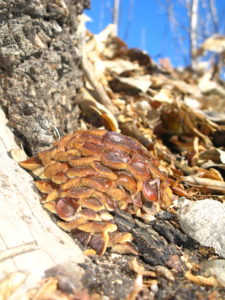
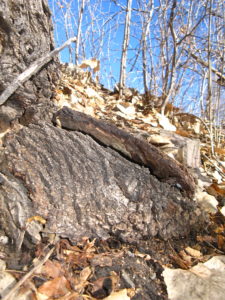
I see this mushroom up, during wet spells, from the end of January through April in general. By the time the morels start to get thick, the enoki have closed shop for the season. Don’t neglect the fall! Generally there is not enough moisture for conducive fruiting conditions but, you know, All The Rain Promises And More! I find them regularly in the fall too when conditions are right, around sand mushroom time.
Oyster Mushroom (Pleurotus pulmonarias) – is the common oyster we have in Denver/CO that is generally host specific to cotton wood trees. In the case of lower Cherry Creek, the variety of oyster that eats cottonwood trees locally extinct. I’ve been searching for oysters on Cottonwood for the last 7 years and I finally found one tree on the extreme east side of the creek that was hosting oyster mushrooms. Since I had not seen them on Cottonwood trees, I was bringing clusters of oyster mushroom from other cottonwood trees down to the creek in the hopes of restoring a population to the area. In the interim, I was ignoring all the other trees. Eventually I figured out that there were plenty of oysters in the area but they were growing on tall Willow and not cottonwood trees.
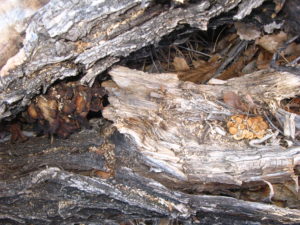
I also see them on narrow leaf Cottonwood’s (another popular genus) that is actually a hybrid of the tall Willow and planes Cottonwood tree. But not in this particular location. Oyster Mushroom (Pleurotus ostreatus) Yes, we do have the eastern oyster in Denver, 4 sure. Almost 10 years ago when I 1st started looking for mushrooms, I found an oyster mushroom growing on the edge of a fairway of a golf course. There was no wood associated with it up to 18 inches below the sandy gravel that the mushroom was fruiting in. What the mycelium had done was to grow through the sand and pebbles and had can created the aggregate together as if it were Portland cement. It was basically fruiting on a concrete platform, my “ground oyster”. I showed it to a few people but was told that oysters only fruit on wood. This is true but somebody forgot to tell this mushroom. I ultimately sent it to Rita’s Vilgalys at Duke University, he is a well-known Pleurotus expert. He did a PCR DNA test and it came back that it was indeed a Pleurotus species but not the usual suspect. It was the eastern oyster! Which ultimately made sense the next time I found this species, it was growing on a super hard wood Russian Olive tree stump. I could tell it was the ostreaus due to the very dark color of the caps, almost black where the local pulmonarius is a lighter shade of brown/gray. What had happen on the golf course is that they had expanded the fairway and had covered a Russian Olive tree grove and the mycelium found a way to survive & quite frankly, thrive. These critters never cease to amaze me.
Finally, the most interesting oyster tidbit: our local city oyster has found a new non-poplar food source and I am now finding more oysters on Siberian Elm (Ulmas pumila) than on cotton, narrow leaf cotton & standing willow (poplars) combined! The 1st mushroom of the year I found was growing on a Siberian elm log in front of my house in the 1st week of January. Very unusual, a 1st for me this early in the season. Take a look around your hood, there are probably some in the next ally! All you need to do is find a dead Siberian elm and that’s not too hard a task these days. CMS also found oyster mushrooms on the foray that had been up (and dried somewhat) prior to the enoki mushroom cluster that we had found. The oyster was fruiting on a standing willow tree. I believe this was due to the fact that the air temperatures were higher than the ground temperatures early in the season this year. The oysters tend to fruit more airily than the Enoki which tend to fruit between the stump base and the ground. Ground was frozen while the wood off the ground was nice and toasty. At least for a mushrooms taste. I harvested some of the “dry” oysters, moistened them & let them cold-incubate for a week & a half. They have reconstituted and are currently growing vegetative mycelium out the sides of the stem butt. I will train/cold-incubate them into a non-host specific mycelium that eats general wood chips. But this will be a story for another article in the near future.
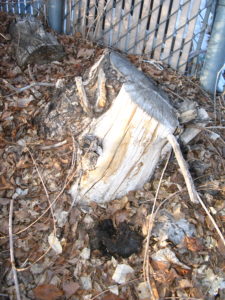
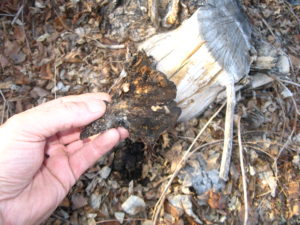
⦁ Dry mushrooms – this is perfect time year to look for dried mushrooms that were out last year, freeze dried and are now “indicators” of the type of mushrooms that resides in that particular log you are looking at. Denver has a particularly dry climate so mushrooms desiccate fairly easily. They can survive dry for a surprisingly long time when the conditions are right. Last year was actually an excellent year for this freeze-drying process to happen. We had our 1st cold snap on October 14 with temperatures of 10°. Prior to that it been in the 50s and 60s and moist. Most of the mushrooms we found on the CMS foray were of the dry variety. We found 2 tree stumps with Dryad’s Saddle and two with oyster mushrooms in addition to the fresh Enoki.
Figure 7 Dry dryad’s saddle mushroom on Siberian Elm Feb 2019
Figure 8 Close-up of dry dryad’s saddle mushroom on Siberian Elm Feb 2019. Notice the degraded pores vs degraded gills on the dry oyster above.
⦁ Not too bad for a mile walk this time of year. Enokis are often desiccated as well, although we didn’t find any on this particular trip. The other species of mushrooms that I often find dry are Turkey tail, Hemipholiota populania, myxomycet spore clusters, Hericium Americana, Agaricus species & Polyporus aricularia
Vulvaria bombacina- “Da Bomb” usually comes out in august and gets roasted many times in the mile high Colorado sun. If the season is dry, the desiccated fruit can last well into the winter. It’s a medium sized white mushroom with pinkish gills. Don’t waste your time looking for it early if you do find one. The first dry fruit I found was in the winter. I spent two seasons looking @ a hackberry tree till I found the first live fruiting body in August and figured out what was up. The reason I believe this mushroom is so “rare” is that it is out in the low lands during late July and August. Who in their right mind is looking for mushrooms in the low lands during monsoon season when there are king boletes, chanterelles and matsutakes to be had in the mountains?? I suspect this guy is a secondary decomposer like the enoki as I generally find it on well decomposed trees. It’s not picky and I have found this species on Siberian elm, Hackberry, Oak, silver maple, standing willow and cottonwood. It’s an absolutely delicious mushroom but I generally don’t pick them as they are so uncommon. One that I prefer to bring home photos of. A word of caution: this species grows out of a volva and could be mistaken for an Amanita species. Know what you are looking at 4 sure. It’s not likely that an Amanita would be growing on the same wood that the bomb likes but Amanita can grow out of well decomposed wood, don’t be complacent. The easiest way to tell the difference is that the bomb has pink gills/spore print vs white gills/spore print of the Amanita.
⦁ Indicator spots- the easiest way to figure out if a particular mushroom is out is to find yourself an indicator spot. You can also create them but I’ll go over this in section 9 below. My current enoki Indicator spot is an old growth cottonwood stump that has been mechanically ground out in the center. This in essence creates a hole in the ground that collects leafs, grass and other debris which hold moisture & heat. It is also slightly below ground level so it also blocks some of the direct wind. The edges of the hole are the sheared faces of the massive underground root system of the cottonwood upon which the enoki fruit. The stump remnants are on the north side of an East/West oriented street, meaning that it has a direct southern exposure. A street comes directly from the South and dead ends into the East/West oriented Street directly in front of the indicator spot. This means that there are no trees directly south of the stump allowing sunlight to hit my spot all day long. When that little “Magnum PI” voice in my head tells me it’s time to go look for enoki, that’s where I head. 90% of the time, there are the little guys that were making all the racket in my head. This starts the process of me looking @ the warmest spots where they are known to reside to the coolest. There can easily be 2 months between the 1st emergence of a perfectly southern oriented mushroom and a perfectly northern oriented mushroom. That is why this information is important to have, it allows you do more finding than looking.
⦁ Ground Temerature- use of a thermometer to find mushrooms will come into play later in the year, it’s not generally applicable at this time of year. The ground can range from frozen to balmy and back to frozen. In general though, when the ground hits a certain temperature the mushrooms start to activate. If the ground temperature drops they generally go more or less dormant and wait for it to warm back up to continue their growth. Most of these early mushrooms can freeze solid every night, defrost the next day, and keep on growing. I have crocus up in my front yard since the 1st week of Jan. & have Daffodils up now, emerging mid-February. Highly unusual & indicates an early spring & this point in the season. I will come back to this subject in April when it becomes more useful for hunting morels, which are ground temperature sensitive. In general, for morels, if you are seeing 45° ground temps it’s time to start looking for yellows. The sweet spot being 49° to 52°. When you see 55° temperatures, it’s time to head up the hill and look for black morels.
A pair of young Yellow Morels (Photo: Courtesy of David Nazeri.)
⦁ Conservation of mushroom resources – Here are some techniques to help the mushrooms that you do find from prematurely drying out. With enokis, they are generally growing on well decomposed stumps between the stump and the ground. Since the tree is well decomposed, the bark is generally loose and can be used as a barrier/container to keep sun directly off the fruit & to keep moisture in. This is what CMS did with the enoki we found on this foray. They are still there a week after we found them. I can’t be sure if they will recover, the temps have been down into the single digits and I don’t know the lows that they can survive. I’m sure there is a lower limit but I don’t know what that is yet. I will continue to monitor them and see if they recover. The other way that I accomplish this is to use soaked 10” peat pots.
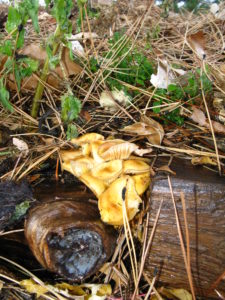
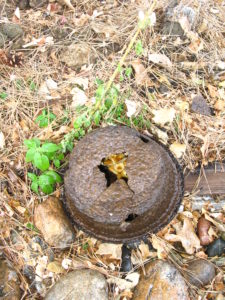
I soak the pot and place it upside down directly over the mushroom. They have “ventilation” holes in the top now to let air in and spores out while shading the fruit and retaining humidity! I generally do these in my yard but have been surprised that I have been able to successfully use this technique in public settings. I used this technique on my indicator spot last year and despite the fact that hundreds of people walked by the spot EVERY DAY, no one bothered the peat pot container. I guess I shouldn’t be surprised, if people didn’t see the mushrooms and bother them, why would they see some brown “trash” amongst the dead leaves? I generally check the spot a couple times a week (dependent on the weather) and rewet as necessary. Generally each time I go ‘cause Denver tends to be dry. When it is wet though, you may not want to water @ all or even remove the lid if we happen to have a wet spell. A cover can over humidify the fruit and rot it having the opposite effect of conservation. There is a little bit of art involved but this is mainly science.
2017 Bark tent in action with Enoki:
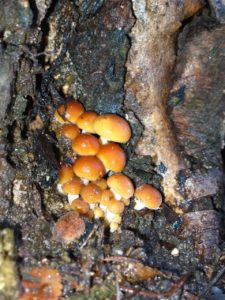
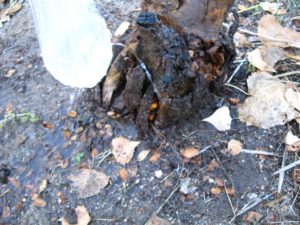

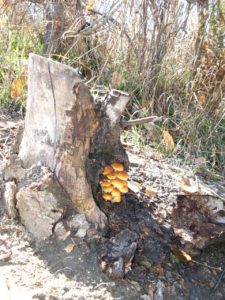
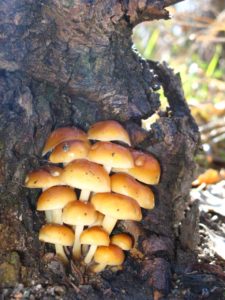

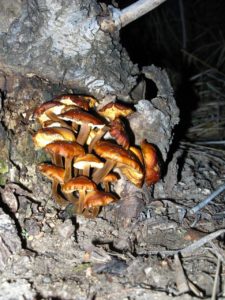
Picture# 8-N/A
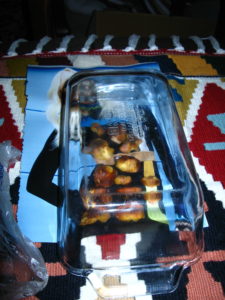

James Wieser is a self-educated Experimental and Theoretical Mycologist & Integrated Natural Systems Engineer. Publishes Carbon Negative Agriculture.com, Carbon Negative Forestry.com, the 2nd Agricultural Revolution.com & the 2nd Enlightenment.com. Director of the Center for Experimental and Theoretical Integrated Mycology, Denver (CETIM-Denver). He is a leading edge researcher in the introduction of mushrooms into our suburban habitat, working with 95 species in 2019.
